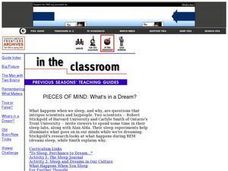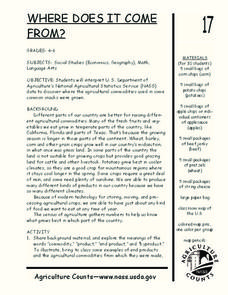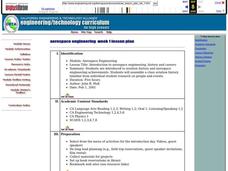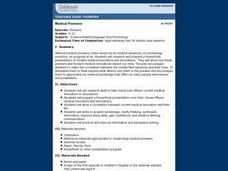Curated OER
As You Like It
Learners use online resources in order to examine patterns of imagery in As You Like It. By comparing these patterns to those of other Shakespeare plays, students draw conclusions about the different reasons Shakespeare uses imagery in...
Curated OER
Caesar
Students examine patterns of imagery in Caesar by using online resources. Students compare the patterns they see to those they've found in other Shakespeare plays. Then students draw conclusions about why Shakespeare might have used the...
Curated OER
Hamlet
Young scholars examine patterns of imagery in Hamlet by using online resources. Students compare the patterns they see to those they've found in other Shakespeare plays. Then young scholars draw conclusions about why Shakespeare might...
Curated OER
Richard II
Learners examine patterns of imagery in Richard II by using online resources. Students compare the patterns they see to those they've found in other Shakespeare plays. Then learners draw conclusions about why Shakespeare might have used...
Curated OER
Exploring Facets of life in the 1930s presented in John Steinbeck's Of Mice and Men
Ninth graders research various aspects of The Great Depression. They select a topic related to this information. Students gather five sources on their topic and select the most important information. They present information using a...
Curated OER
The Study of the Spanish-Speaking People of Texas: Daily Life
Students analyze the different ways that photography helps historians understand the lives of people who lived in the past. They examine images from Russell Lee's photo essay and discuss how Texas' has changed from an agrarian to an...
Curated OER
Supporting the Classics!
High schoolers identify the basic forms of classical architectural columns. Using the internet, they note the physical differences between Corinthian, Doric and Ionic columns. They design their own temple to their favorite Greek god or...
Curated OER
Where Does It Come From?
Students explore where agricultural commodities used in snack foods are grown. They choose a snack food and locate the top five states that produce the food that the snack is made from.
Curated OER
Pieces of Mind: What's In A Dream?
Students explore the five stages of sleep. They view video footage of sleep labs and discuss the findings. Students conduct experiments by keeping a sleep journal to track their sleep and dream activity. They find examples of ways...
Curated OER
The Ancient Maya
Young scholars explore the culture of the Mayans through a variety of activities. In this lesson about Maya, students analyze pictures in books and on websites, produce scale models of Maya architecture, and create Maya mosaics. Young...
Curated OER
Where Does It Come from?
Students read articles about various agricultural products and create a map using the statistics in the article. In this agricultural statistics lesson, students look at the geography of the country and which products come from the...
Curated OER
Math for the Frontier
Make history come to life by using the Frontier House series to engage students in the past. Your class will "prepare" for a trip to 1833 Montana. They will learn about homesteading, frontier life, inflation, and cost of living. Using...
Curated OER
Cyberspace Safari
Middle schoolers go on an information gathering hunt on the Internet to study West African empires. They work in teams; meteorologists, bankers, writers, and archaeologists. They collect data on all sorts of topics related to West...
Curated OER
Surviving the Winter
Fifth graders investigate given cultures using the internet, personal interviews and other sources, They examine how the civilizations of six Native American tribes and six Australian Aboriginal tribes survived during their respective...
Curated OER
Aerospace Engineering
Students are introduced to aviation history and aerospace engineering achievements. They assemble a class aviation history timeline from individual student research on people and events.
Curated OER
Jazz In America
Students explore the Jazz Era in America not only by answering questions but listening to music as well.
Curated OER
Medical Pioneers
Learners use research skills to take notes over fifteen current medical innovators or innovations. They prepare a PowerPoint presentation over their chosen fifteen medical innovators and innovations. Students show a correlation between...
Curated OER
Rocks, Minerals, and Erosion
Fourth graders describe the difference between minerals (composed of the same substance throughout) and rocks (composed of two or more minerals). They recognize that there are three classes of rocks: igneous, sedimentary, and metamorphic
Curated OER
Egypt's golden Empire
Learners explore many of the key scientific and technological contributions made by the ancient Egyptians. Researched data is presented to the entire group.
Curated OER
Living With Risk: The Human Element of Natural Disasters
Students explore human elements that are a part of natural disasters, read a Hawaiian myth, conduct a survey, discuss why people choose to live in high risk areas, and participate in a writing activity based on studenT real life accounts...
Curated OER
Digital Divide
Students research different "divides" and apply their research to the Digital Divide. They determine the race, gender and socioeconomic issues involved in this issue and why it is relevant.
Curated OER
The Proof of the Century!
Young scholars do Web research in the field of mathematics. They explore mathematical proofs and apply them to the Pythagorean theorem. They also explore the general ideas of Fermat's Last Theorem
Curated OER
Keystone Science School: Sustainable Automobiles
Students explore how to choose the correct car for them based on their needs.
Curated OER
Exploring Islamic Lands
Students examine the lives of Islamic teens. In this global studies lesson, students explore selected Internet sites to discover the attributes of Islam, the cultural traditions of Islam, and information regarding Middle Eastern...

























